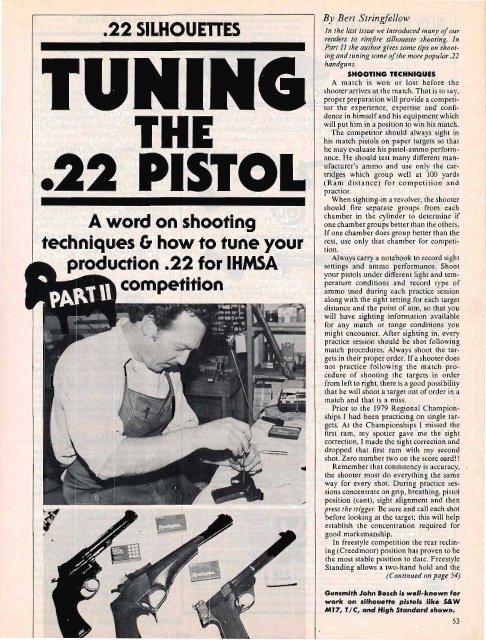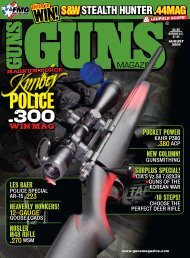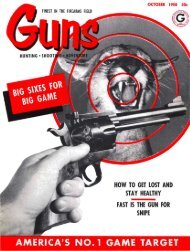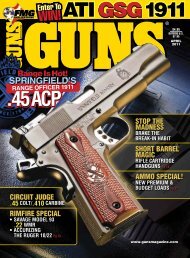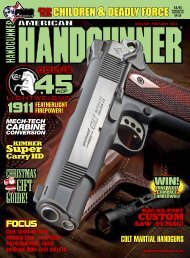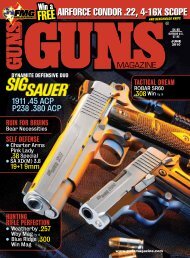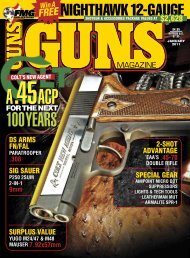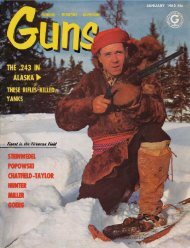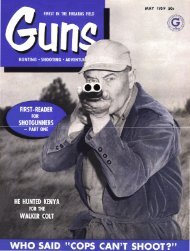American Handgunner Jul/Aug 1981 - Jeffersonian
American Handgunner Jul/Aug 1981 - Jeffersonian
American Handgunner Jul/Aug 1981 - Jeffersonian
Create successful ePaper yourself
Turn your PDF publications into a flip-book with our unique Google optimized e-Paper software.
.22 SILHOUEnES<br />
THE<br />
.22 PISTOL<br />
A word on shooting<br />
techniques 6 how to tune your<br />
production .22 for IHMSA<br />
competition<br />
By Bert Stringfellow<br />
In the last issue we introduced many ofour<br />
readers to rimfire silhouette shooting. In<br />
Part II the author gives some tips on shoot- .<br />
ing and tuning some ofthe morepopular .22<br />
handguns.<br />
SHOOTING TECHNIQUES<br />
A match is won or lost before the<br />
shooter arrives at the match. That is to say,<br />
proper preparation will provide a competitor<br />
the experience, expertise and confidence<br />
in himself and his equipment which<br />
will put him in a position to win his match.<br />
The competitor should always sight in<br />
his match pistols on paper targets so that<br />
he may evaluate his pistol-ammo performance.<br />
He should test many different manufacturer's<br />
ammo and use only the cartridges<br />
which group well at 100 yards<br />
(Ram distance) for competition and<br />
practice. .<br />
When sighting-in a revolver, the shooter<br />
should fire separate groups from each<br />
chamber in the cylinder to determine if<br />
one chamber groups better than the others.<br />
Ifone chamber does group better than the<br />
rest, use only that chamber for competition.<br />
Always carry a notebook to record sight<br />
settings and ammo performance. Shoot<br />
your pistols under different light and temperature<br />
conditions and record type of<br />
ammo used during each practice session<br />
along with the sight setting for each target<br />
distance and the point of aim, so that you<br />
will have sighting information available<br />
for any match or range conditions you<br />
might encounter. After sighting in, every<br />
practice session should be shot following<br />
match procedures. Always shoot the targets<br />
in their proper order. Ifa shooter does<br />
not practice following the match procedure<br />
of shooting the targets in order<br />
from left to right, there is a good possibility<br />
that he will shoot a target out of order in a<br />
match and that is a miss.<br />
Prior to the 1979 Regional Championships<br />
I had been practicing on single targets.<br />
At the Championships I missed the<br />
first ram, my spotter gave me the sight<br />
correction, I made the sight correction and<br />
dropped that first ram with my second<br />
shot. Zero number two on the score oord!!<br />
Remember that consistency is accuracy,<br />
the shooter must do everything the same<br />
way for every shot. During practice sessions<br />
concentrate on grip, breathing, pistol<br />
position (cant), sight alignment and then<br />
press the trigger. Be sure and call each shot<br />
before looking at the target; this will help<br />
establish the concentration required for<br />
good marksmanship.<br />
In freestyle competition the rear reclining<br />
(Creedmoor) position has proven to be<br />
the most stable position to date. Freestyle<br />
Standing allows a two-hand hold and the<br />
(Continued on page 54)<br />
Gunsmith John Bosch is well-known for<br />
work on silhoueHe pistols like S& W<br />
M J7, T/ C, and High Standard shown.<br />
53


